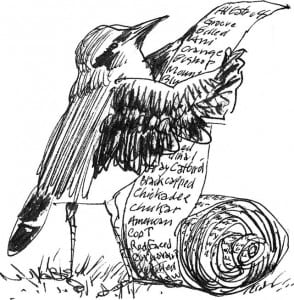When I finished the three-page introduction to The Ardent Birder I concluded, with a yawn, that while very sweet and even tender the book seemed far too basic for an experienced birder like myself. But I found the bordering-on-theprecious tone disarmingly honest and refreshing, and the arrangement of material suggested by the contents meticulously sensible, so I decided to read at least a few short chapters. On the second page of the first chapter, my yawn somersaulted into a smile as I reached for a pencil to mark the first of many statements I would mark by the time I finished the book, in a single sitting:
“When life touches life, our heart responds, whatever sense our head, looking on, makes of the occasion. And so I would venture that birding, for all its skill and paraphernalia, is at base an emotional enterprise.” A few chapters later, the author observes, “When we hear a bird sing, I believe we feel, for that instant, somehow less alone.”
The Ardent Birder: On the Craft of Birdwatching is that rare bird indeed—a sensitive, well-informed, loving, funny and thorough primer on how to watch birds, for everyone from rank beginners to jaded experts who lead bird walks. I put the book down wanting to go birdwatching immediately, with the author. Todd Newberry, who earned a B.A from Princeton and a Ph.D. in zoology and marine biology from Stanford, taught at the University of California, Santa Cruz, for 30 years and has taught, as professor emeritus, for the last 10 at the latter university’s Long Marine Lab. A lifelong birder, his academic specialty is modular animals, such as most corals and, his favorites, sea squirts. He brings to the table the rigor of a scientist suffused with the infectious enthusiasm of a crazed birder.

The combination works. He kept astonishing me with fresh insights into the most basic aspects of birding, such as stalking a bird in order to get a closer look. His discussion of what not to do when stalking a bird reads like an almost perfect description of my technique, which I radically altered the following day. He advises avoiding eye contact with the bird and approaching diagonally, “by using zigzag, oblique routes and presenting side views of ourselves.” He feels, correctly I think, that “…birds seem to take alarm at symmetry: frontal views, stereo eyes. That is the posture from which most predators’ attacks begin.” He feels that stalking can generate beauty in a sort of interspecies recognition, the shared awareness of another animal: “Successful stalk or not, I find that the thrills of mutual attention—the bird’s and mine together as the distance between us closes, and then the relaxation as we part—are among the reasons I go birding.”
The book consists of 49 small chapters arranged into six sections (“Our Day,” “Our Year,” “A Philosophical Interlude,” “Skills,” “Gear” and “Leading Better Club Trips”), each of them filled with tips, tricks, theories, asides and fascinating factoids. Dr. Newberry (he never refers to himself using any of his titles, but his credentials are so impeccable I felt it would be sacrisecular to call him Mr.) sprinkles his writing with quotations by everyone from Yogi Berra (“You can observe a lot by watching.”) to Marcel Proust (“The real voyage of discovery consists not in seeking new landscapes but in having new eyes.”).
My favorite section, “Skills,” describes a technique for getting on a bird (finding it with your binoculars) that I have struggled with over the years, especially when trying to help children and people not used to binoculars. The problem is classic: Someone sees the bird with the naked eye, raises his or her binoculars to their eyes and winds up looking at a field of view that doesn’t even come close to including the bird. This syndrome frustrates people, to say nothing of the people trying to help them, real fast. The author, crediting another birder for teaching it to him, offers this technique:
“Keeping your eyes on the bird, first raise your binoculars to face level but hold them vertically (that is, aimed straight down at the ground), so your thumbs rest against your cheekbones. Then rotate the binocs to your eyes as if they were hinged to your cheeks. Now look through them.”

The technique works, as does his method for practicing counting things in tens so that it becomes almost automatic to visualize ten items, a skill that handily translates into an enhanced capacity to count large numbers of birds quickly. I can remember dozens of times a large flock of snow or Canada geese, honking or squawking maniacally, descended as I tried hopelessly to count them, only to hazard a wild guess at their numbers.
The “Skills” section also includes a fun riff on pishing, the making of pish-pish noises to attract birds, which, in my experience, sometimes works and sometimes doesn’t. Dr. Newberry reports that, unlike American birders, European birders don’t pish and that the birds there don’t respond to this lure.
“But maybe I spoke too quickly,” he continues. “If when in Italy, you visit the great basilica at Assisi, look at Giotto’s 13th-century fresco of Saint Francis preaching to the birds. His lips are puckered. The birds gathered at his feet listen attentively. He is pishing.”
In addition to its considerable knowledge, warmth, charm and humor, The Ardent Birder features 82 playful cartoons that illustrate the author’s points. There’s one of a tea kettle impersonating a bird, in order to fool a birder, that had me smiling thinking about all the inanimate objects I’ve mistaken for birds.